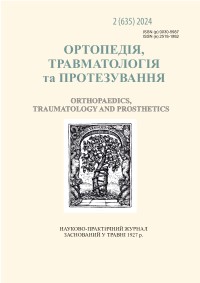SYME’S OPERATION IN THE TREATMENT OF GUNSHOT INJURIES OF THE FOOT
DOI:
https://doi.org/10.15674/0030-5987202425-10Keywords:
Foot, gunshot injury, Symeʼs operationAbstract
Symeʼs operation for gunshot injuries of the foot may be a viable alternative to transtibial amputation. Objective. To analyze the results of the use of Symeʼs operation in patients with gunshot injuries of the foot, to highlight the important points of surgical technique, rehabilitation and prosthetics. Methods.
The results of treatment of 12 men with gunshot wounds to the foot aged 23–54 years (mean age (36.1 ± 2.7) years) who underwent Syme surgery were analyzed. All patients were military personnel at the time of injury. Clinical, instrumental and microbiological examinations were used. The severity of the injury and the prospects of reconstructive treatment were assessed by the Hannover Fracture Score (HFS-97), the anatomic defect present and the severity of static-dynamic disorders. The results were evaluated according to VAS (pain) and ALAC (prosthesis using). Results. Healing of postoperative wounds in all cases occurred without complications. The observation period was from 8 months. up to 7 years (3.5 years on average). All 10 prosthetic patients use a prosthesis: 1 — walking on a prosthesis outside the home (ALAC IV), 5 — independent mobility (ALAC V), 4 — mobility does not differ from the norm (ALAC VI). In two cases (15,4 %) due to pain syndrome (7,3 and 6,8 according to VAS) prosthetics was impossible — reamputation at the level of the leg. Conclusions. Syme’s operation provides a good functional result of prosthetics in case of gunshot injuries of the foot, is a real alternative to transtibial amputation in cases with preserved hindfoot.
References
- Hudson, J. R., Yu, G. V., Marzano, R., & Vincent, A. L. (2002). Syme’s amputation: surgical technique, prosthetic considerations, and case reports. Journal of American Podiatric Medical Association. 92 (4), 232–246. https://doi.org/10.7547/87507315-92-4-232.
- Braaksma, R., Dijkstra, P. U., & Geertzen, J. H. B. (2018). Syme amputation: a systematic review. Foot and Ankle International. 39(3), 284–291. https://doi.org/10.1177/1071100717745313.
- Krettek, C., Seekamp, A., Kontopp, H., & Tscherne, H. (2001). Hannover Fracture Scale 98 — reevaluation and new perspectives of an established extremity salvage
- score. Injury. 32(4), 317–328. https://doi.org/10.1016/s0020-1383(00)00201-1.
- Campbell, W. B., Johnston, J. A. St., Kernick, V. F. M., & Rutter, E. A. (1994). Lower limb amputation: striking the balance. Annals of the Royal Colleege of Surgeons of England. 76(2), 205–209. PMID: 7755684.
- Syme, J. (1824). Remarks on amputation. Edinburg Medical Surgical Journal. 21(78), 27–42. PMCID: PMC5826404.
- Pinzur, M. S. (1999). Restoration of walking ability with Syme’s ankle disarticulation. Clinical Orthopedics and Related Research. 361, 71–75. https://doi.org/10.1097/00003086-199904000-00010.
- Rathore, F. A., Ayaz, S. B., Mansoor, S. N., Qureshi, A. R., & Fahim, M. (2016). Demographics of lower limb amputations in the Pakistan military: a single center, three-year prospective survey. Cureus. 8(4), e566. https://doi.org/10.7759/cureus.566.
- Krueger, C. A., Wenke, J. C., & Ficke, J. R. (2012). Ten years at war: comprehensive analysis of amputation trends. Journalof Trauma and Acute Care Surgery. 73(6 Suppl 5), S438–444. https://doi.org/10.1097/TA.0b013e318275469c.
- Necmioglu, S., Subasi, M., Kayikci, C., Young, D. B. (2004). Lower limb landmine injuries. Prosthetics and Orthotics International. 28(1), 37–43. https://doi.
- org/10.3109/03093640409167923
Downloads
How to Cite
Issue
Section
License

This work is licensed under a Creative Commons Attribution 4.0 International License.
The authors retain the right of authorship of their manuscript and pass the journal the right of the first publication of this article, which automatically become available from the date of publication under the terms of Creative Commons Attribution License, which allows others to freely distribute the published manuscript with mandatory linking to authors of the original research and the first publication of this one in this journal.
Authors have the right to enter into a separate supplemental agreement on the additional non-exclusive distribution of manuscript in the form in which it was published by the journal (i.e. to put work in electronic storage of an institution or publish as a part of the book) while maintaining the reference to the first publication of the manuscript in this journal.
The editorial policy of the journal allows authors and encourages manuscript accommodation online (i.e. in storage of an institution or on the personal websites) as before submission of the manuscript to the editorial office, and during its editorial processing because it contributes to productive scientific discussion and positively affects the efficiency and dynamics of the published manuscript citation (see The Effect of Open Access).














